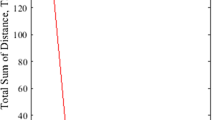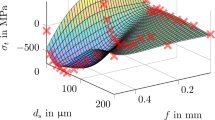Abstract
Residual stresses are normally generated in any cutting operation. However, while compressive residual stresses are sometimes suitable as they may even enhance and improve the piece life, tensile residual stresses can be very detrimental representing a negative feature for fatigue life, corrosion, strength and other functional aspects. Thus, a proper set-up of the process parameters in machining operations has a dramatic importance. Currently, optimization methodologies do not seem to be very effective for industrial needs, for which the optimal setup being a desired residual stresses profile becomes a relevant issue. On the basis of the previous considerations, this work proposes a data mining technique, which has proven to be reliable to identify the analytical relationship between residual stresses and the proper process parameters. In order to ensure the use of the developed technique in practice, it has been integrated in the user-friendly software, Predators®.
Similar content being viewed by others
References
Astakhov V.P. (1999) Metal cutting mechanics. CRC Press, Boca Raton, FL
Childs T.H.C., Maekawa K., Obikawa T., Yamane Y. (2000) Metal machining-theory and application. Oxford, UK, Elsevier Ltd
Dimla D.E. Sr. (1999) Application of perceptron neural networks to tool state classification in metal-turning operation. Engineering Applications of Artificial Intelligence 12: 471–477. doi:10.1016/S0952-1976(99)00015-9
Dimla D.E. Sr., Lister P.M. (2000) On-line metal cutting tool condition monitoring. II: Tool-state classification using multi-layer perceptron neural networks. International Journal of Machine Tools & Manufacture 40: 769–781. doi:10.1016/S0890-6955(99)00085-1
Ezugwu E.O., Fadare D.A., Bonney J., Da Silva R.B., Sales W.F. (2005) Modelling the correlation between cutting and process parameters in high-speed machining of Incotel 718 alloy using an artificial neural network. International Journal of Machine Tools & Manufacture 45: 1375–1385. doi:10.1016/j.ijmachtools.2005.02.004
Hua J., Shivpuri R., Umbrello D. (2006) Investigation of cutting conditions and cutting edge preparations for enhanced compressive subsurface residual stress in the hard turning of bearing steel. Journal of Materials Processing Technology 171(2): 180–187. doi:10.1016/j.jmatprotec.2005.06.087
Jawahir I.S., Balaji A.K., Rouch K.E., Baker J.R. (2003) Torwards integration of hybrid models for optimized machining performance in intelligent manufacturing systems. Journal of Materials Processing Technology 139: 488–498. doi:0.1016/S0924-0136(03)00525-9
Jawahir I.S., Wang X. (2007) Development of hybrid predictive models and optimization techniques for machining operations. Journal of Materials Processing Technology 185: 46–59. doi:10.1016/j.jmatprotec.2006.03.133
Jiao Y., Lei S., Pei Z.J., Lee E.S. (2004) Fuzzy adaptive networks in machining process modeling: Surface roughness prediction for turning operations. International Journal of Machine Tools & Manufacture 44: 1643–1651. doi:10.1016/j.ijmachtools.2004.06.004
Kalpakjian S., Schmid S.R. (2003) Manufacturing processes for engineering materials (4th ed). Upper Saddle River, NJ, Prentice Hall
Kim D.J., Kim B.M. (2000) Application of neural network and FEM for metal forming processes. International Journal of Machine Tools & Manufacture 40: 911–925. doi:10.1016/S0890-6955(99)00090-5
Lee E.H., Shaffer B.W. (1951) The theory of plasticity applied to a problem of mechanics. Transactions of the ASME Journal of Applied Mechanics 18: 405–413
Liu T.L., Chen W.Y., Anantharaman K.S. (1988) Intelligent detection of drill wear. Mechanical Systems and Signal Processing 12(6): 863–873
Matsumura T., Obikawa T., Shirakashi T., Usui E. (1994) An adaptive prediction of machining accuracy in turning operation. Transactions of NAMRI/SME 22: 305–312
Matsumura T., Sekiguchi H., Usui E. (1994) Autonomus operation planning with the identification of machine tool characteristics. Transactions of NAMRI/SME 22: 313–318
Merchant M.E. (1945) Mechanics of metal cutting process. Journal of Applied Physics 16: 318–324. doi:10.1063/1.1707596
Oxley P.L.B. (1989) Mechanics of machining. Ellis Horwood, Chichester
Oxley P.L.B., Palmer W.B. (1959) Mechanics of metal cutting. Proceedings of the Institution of Mechanical Engineers. Part H, Journal of Engineering in Medicine 173: 623. doi:10.1243/PIME_PROC_1959_173_053_02
Raj K.H., Sharma R.S., Srivastava S., Patvardhan C. (2000) Modeling of manufacturing processes with ANNs for intelligent manufacturing. International Journal of Machine Tools & Manufacture 40: 851–868. doi:10.1016/S0890-6955(99)00094-2
Shaw M.C. (2005) Metal cutting principles (2nd ed). Oxford University Press, New York, NY
Sick B. (2002) On-line and indirect tool wear monitoring in turning with artificial neural networks: A review of more than a decade of research. Mechanical Systems and Signal Processing 16: 487–546
Trent E.M., Wright P.K. (2000) Metal cutting (4th ed). Woburn, MA, Butterworth Heinemann.
Umbrello, D. (2005). FE—Analysis of machining processes: Innovative experimental techniques for results assessing. Ph.D thesis, Mechanical Engineering, University of Calabria.
Umbrello D., Ambrogio G., Filice L., Shivpuri R. (2008) A Hybrid FEM-ANN approach for predicting residual stresses and the optimal cutting conditions during hard turning of AISI 52100 bearing steel. Materials & Design 29(4): 873–883. doi:10.1016/j.matdes.2007.03.004
Umbrello D., Hua J., Shivpuri R. (2004) Hardness based flow stress for numerical modeling of hard machining AISI 52100 bearing steel. Materials Science and Engineering A 347: 90–100
Witten I.H., Frank E. (2005) Data mining: Practical machine learning tools and techniques (2nd ed). San Francisco, Morgan Kaufmann Publishers
Zorev N.N. (1966) Metal cutting mechanics. Pergamon Press, Oxford
Zuperl U., Cus F., Mursec B., Ploj T. (2004). A hybrid analytical-neural network approach to the determination of optimal cutting conditions. Journal of Materials Processing Technology, 157–158, 82–90. doi:10.1016/j.jmatprotec.2004.09.019.
Author information
Authors and Affiliations
Corresponding author
Rights and permissions
About this article
Cite this article
Umbrello, D., Ambrogio, G., Filice, L. et al. A clustering approach for determining the optimal process parameters in cutting. J Intell Manuf 21, 787–795 (2010). https://doi.org/10.1007/s10845-009-0254-1
Received:
Accepted:
Published:
Issue Date:
DOI: https://doi.org/10.1007/s10845-009-0254-1




